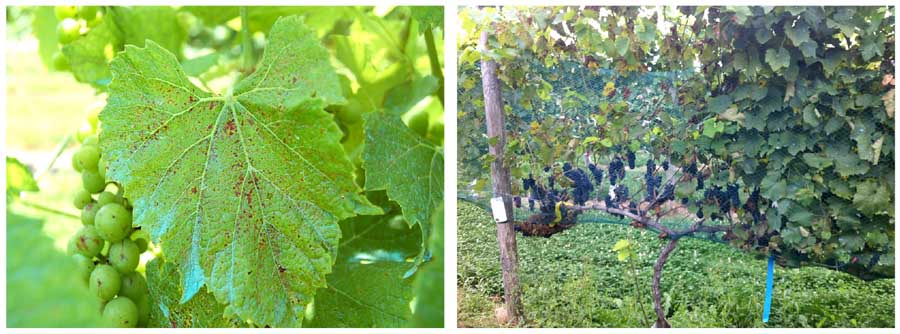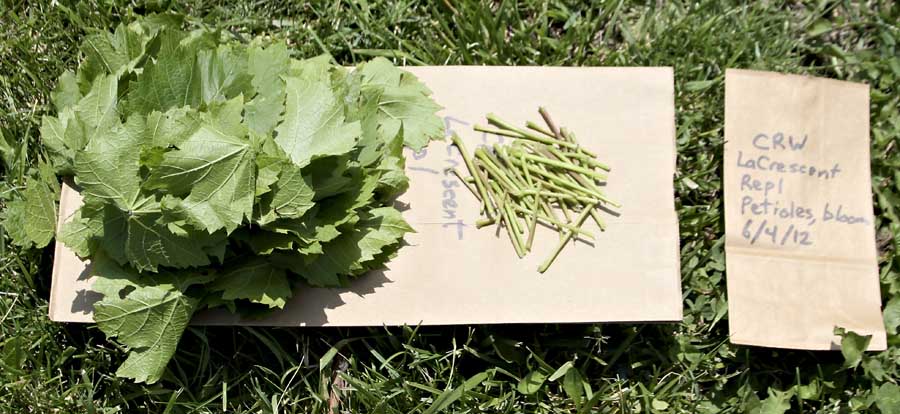
Field researchers harvest grapes at one of the locations in the nutrition study. The research group hopes to provide growers with nutrient sufficiency ranges for Frontenac, Marquette and La Crescent. Courtesy James Crants/University of Minnesota
While years of research and field experience have provided solid information about how to grow European wine grape varieties that yield high-quality juice, the same cannot be said of the cold-hardy grapes that are expanding throughout vineyards in New England and the upper Midwest.
That is starting to change, however, as research associated with the Northern Grapes Project begins to provide insight into cold-hardy cultivars — those based on Vitis riparia.
Funded in 2011 by the National Institute of Food and Agriculture’s Specialty Crop Research Initiative, the Northern Grapes Project is designed to encourage the wine industry in colder climates. The five-year project is wrapping up later this year.
Two of the groups conducting studies on cold-hardy cultivars through the Northern Grapes Project are those of Patricia McManus, professor and chair of the University of Wisconsin-Madison Department of Plant Pathology, who is investigating fungicide phytotoxicity; and Carl Rosen, department head and professor in the University of Minnesota Department of Soil, Water and Climate, who is considering the effect of nutrients on vine health and ultimately on the wine.
Fighting fungus

At left, the variety Brianna was the most sensitive to copper of the 15 cold-hardy varieties in McManus’ trials. Just one or two sprays of the copper fungicide caused a reaction. At right, this Maréchal Foch shows severe sulfur injury/defoliation in the left cordon. The right cordon, which was treated with copper, is fine. Courtesy Patricia McManus
“There are a few fungicides that could have a use in grape production, but people are sometimes afraid to use them because of phytotoxic effects,” McManus said. For instance, copper and sulfur have been used as fungicides for centuries, but both are known to cause injuries to some of the European wine grape varieties.

Patricia McManus
“The issue with northern cultivars is there’s a whole lot less known about them, because most just haven’t been around very long. In fact, if you look at extension literature on copper and sulfur phytotoxicity, the columns next to these cold-climate varieties are filled with question marks,” she said.
For the study, McManus’ group monitored 15 cold-climate varieties in two Wisconsin vineyards over four years. One vineyard is in Door County, which is on a peninsula that juts out into northern Lake Michigan and gets the big lake’s moderating influences, including later springs and cooler summers.
The other vineyard is in Madison, which is located inland in the southern part of the state. Vines at the two sites were randomly selected each season to receive biweekly treatments with one of three types of fungicides — copper, sulfur, or a newer product called difenoconazole, which has been available for a few years — or to receive no fungicide.
The researchers regularly checked the vines for marginal browning, speckling or any other potential leaf injuries and ranked the amount of visible damage.
Among the results:
—As expected, Maréchal Foch and the related cultivar Leon Millot showed high sensitivity to sulfur. “Those two varieties are older ones that have been around for decades, and we knew going into the trial that they had sulfur sensitivity,” McManus said.
—Brianna, which experienced minor injury from sulfur, showed significant damage when treated with copper. “Brianna was the most sensitive to copper of all 15 varieties to the point that in some of our trials, just one or two sprays to Brianna with the copper fungicide caused a reaction,” she said.
—None of the tested varieties showed a negative response to difenoconazole, even though the labels on many difenoconazole-containing products include warnings about their use on hybrid varieties, such as cold-hardy cultivars.
Overall, she was pleased — and somewhat surprised — that the cold-hardy varieties performed so well. “I was expecting to see more of the cultivars react to the fungicides, because we were using high rates of copper and sulfur that were right at the upper limit of what’s recommended on the label,” McManus said.
While they were spraying about every two weeks, she explained that most growers would probably restrict the spraying to a couple of times a year for fungicide resistance management and perhaps one extra spray of sulfur later in the season to control powdery mildew.
Tracking leaf nutrients

Carl Rosen, department head and professor in the University of Minnesota Department of Soil, Water and Climate, presents research results from the Northern Grapes Project at a field day. He is studying the effect of nutrients on vine health and ultimately on the wine. (Courtesy Marjorie Bonse/University of Minnesota)
Rosen’s project on nutrition involves researchers from five universities and includes 16 sites, mainly in the upper Midwest.
“We concentrated on the cold-hardy cultivars Frontenac, Marquette and La Crescent, collected tissue samples either at bloom or at veraison, which are the recommended times for grape production, plus one additional time in between, and developed a background database,” he said. They also gathered data on grape yields and juice quality.
The tissue samples provide insight that soil testing alone cannot, he said.
“The problem with soil tests for established vineyards is that grape roots are prolific and explore large amounts of soil, so while soil tests provide initial information about the site for planting, we think that the tissue tests integrate what is going on in fruiting vines a little bit better.”
By analyzing all of the collected tissue-testing data, he said, they hope to come up with average nutrient values for the three varieties, as well as sufficiency ranges, which would give growers target nutrient ranges for good vine growth and juice quality.
“For instance, if your potassium is low in the leaf tissue, you would need to look at perhaps amending the soil to increase that nutrient,” he said.

Preliminary results from the nutrition study suggest that whole-leaf sampling may be a better gauge of tissue-nutrient level than the common technique of sampling only the petiole. Here, a leaf is separated into blades (left) and petioles (right). (Courtesy Carl Rosen)
Preliminary results suggest that whole-leaf sampling may be a better gauge of tissue-nutrient level than the common technique of sampling only the petiole (the leaf stem).
“We’re still looking at the data so we don’t want to draw definite conclusions quite yet, but we’re finding that sampling the whole leaf or blade tissue at bloom seems to be a relatively good indicator of yeast-assimilable nitrogen,” he said. In addition, their early analyses suggest that vine nitrogen affects yeast-assimilable nitrogen (YAN) and potassium influences juice pH.
The research group has finished its number crunching and will soon be able to provide growers with nutrient sufficiency ranges for Frontenac, Marquette and La Crescent.
While this type of information is critical for understanding these northern varieties, Rosen said growers should keep in mind that nutrition level is just one part of a bigger picture. “There are many factors beyond nutrition that affect juice quality, but this study will give us a little more data to help grow cold-hardy cultivars.”
Both Rosen and McManus lauded the Northern Grapes Project and its focus on cold-hardy varieties.
Rosen remarked, “There just hasn’t been any work done on these cold-hardy cultivars, so we are having to rely mostly on nutrition studies that had been done on Vitis vinifera or Vitis labrusca types. The Northern Grapes Project gives us the opportunity to see if there are actually any differences and determine whether we need to change any of the diagnostic tools that are being used for cold-hardy grape nutrition.”
McManus describes the Northern Grapes Project as “hugely important,” particularly in providing base information to the growing number of people just entering the grape industry in cool climates. “The timing has been really good.”
The end of the Northern Grapes Project later this year, however, does not mean the end of research on cold-hardy grapes, she said.
Her research group, for instance, is now trying to fill another major knowledge gap related to these varieties: One of her graduate students, David Jones, is conducting replicated trials to do an analysis of their disease resistance and provide susceptibility ratings.
This will be another step toward providing growers with information that is based on careful studies of these cold-hardy cultivars.
She added, “One of our main goals is to remove some of those question marks in the extension literature and replace anecdotal observations with real scientific data.” •
ONLINE
For full details on the study, visit bit.ly/1UEZ0dZ
– by Leslie Mertz






Leave A Comment